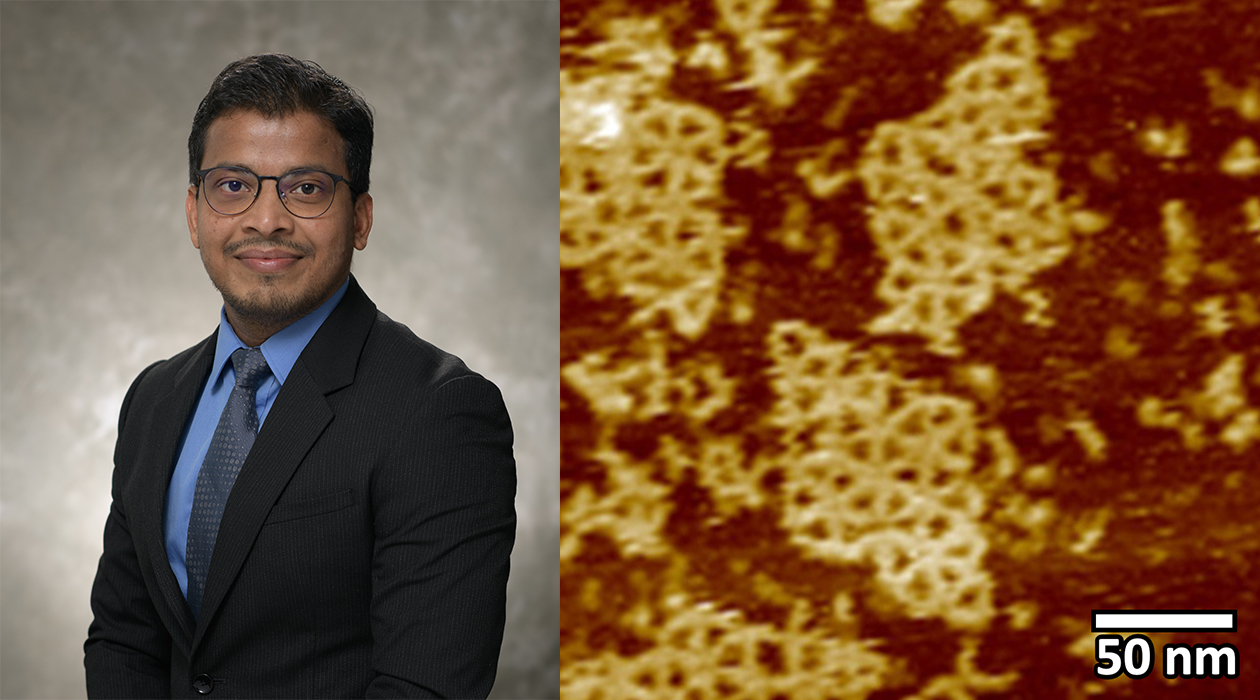New COVID-19 rapid test employs DNA nets for superior accuracy, researchers say

First author Saurabh Umrao (left) with images of DNA nets taken using atomic force microscopy imaging. / Saurabh Umrao
Rapid tests for COVID-19 have become a gold standard for virus testing, widely available at pharmacy chains and drug stores due to their low cost, speed, and ease of use. However, these tests often fall short in accuracy compared to molecular tests like PCR, especially in the early stages of infection. Recently, researchers at the University of Illinois Urbana-Champaign developed a new rapid test that is more reliable and sensitive than commercial tests, by using DNA nanotechnology instead of antibodies to detect the SARS-CoV-2 virus.
Commercial rapid tests for SARS-CoV-2 either the presence of antigens—proteins found on the virus—or antibodies produced by our immune systems in response to infection. While effective when a patient’s infection is well-established, these tests can produce false negatives if conducted too early, when virus levels are low, and the body has not yet mounted a significant immune response. Additionally, prior infection can sometimes trigger a false positive due to lingering antibodies.
The new test, developed by the Illinois team, utilizes DNA nanostructures called DNA nets, specifically designed to bind to the spike proteins on the virus. In a positive sample, the DNA net captures the virus and moves along a test strip, akin to commercial tests. When the virus reaches the test line, which also contains DNA nets, it becomes completely bound. Gold nanoshells intermixed with the nets amplify detection, lighting up to form a bright, easily visible line, indicating a positive COVID-19 result.
“We took advantage of the large amount of research advances that came out of COVID-19.” said Saurabh Umrao, first author on the study and postdoctoral researcher in the lab of Xing Wang (CGD), a bioengineering faculty. “One being DNA aptamers, which are synthetic DNA molecules that you can design so that they are very specific to a single target. When these are added to the DNA nets, it’s like using a fishing net to catch a specific fish; in this case we’re capturing the whole virus.”
Umrao notes that the new test works on multiple strains of SARS-CoV-2 and is 100 times more sensitive than currently available rapid tests, enabling detection of viral loads as low as 103 viral copies/mL, compared to the 105 viral copies/mL needed for standard commercial tests. Furthermore, by modifying the DNA aptamers in the nets, the tests can be tailored to detect other kinds of viruses as well, Umrao said.
“We’ve been applying for grants to generate funds for clinical trials,” said Umrao. “We want to use actual patient samples and show that this technology can be used not only for early detection of COVID-19, but for other concerning diseases respiratory diseases, as well as blood-borne diseases like HIV.”
The team has secured intellectual property for this new technology and is refining the test to enhance its portability and ease of use, said Umrao. They also plan to add another test line to the strip that will show if a patient has influenza as well.
“It is important for people to be able to distinguish whether they have influenza or SARS-CoV-2 to receive the appropriate antiviral therapy,” said Umrao. “But the symptoms for these two diseases are nearly identical. That’s why we plan to add another test line to help people determine which they are infected with.”
Umrao explained that this innovative testing approach aims to make rapid tests more reliable, enabling early and accurate detection of COVID-19 and other infectious diseases. This can help manage and control the spread of infections, improving healthcare outcomes for individuals and communities worldwide.
The study is published in Analytical Chemistry, and was funded by the National Institute on Alcohol Abuse and Alcoholism, and the National Institute of Dental and Craniofacial Research. The paper can be found at https://doi.org/10.1021/acs.analchem.3c03698
